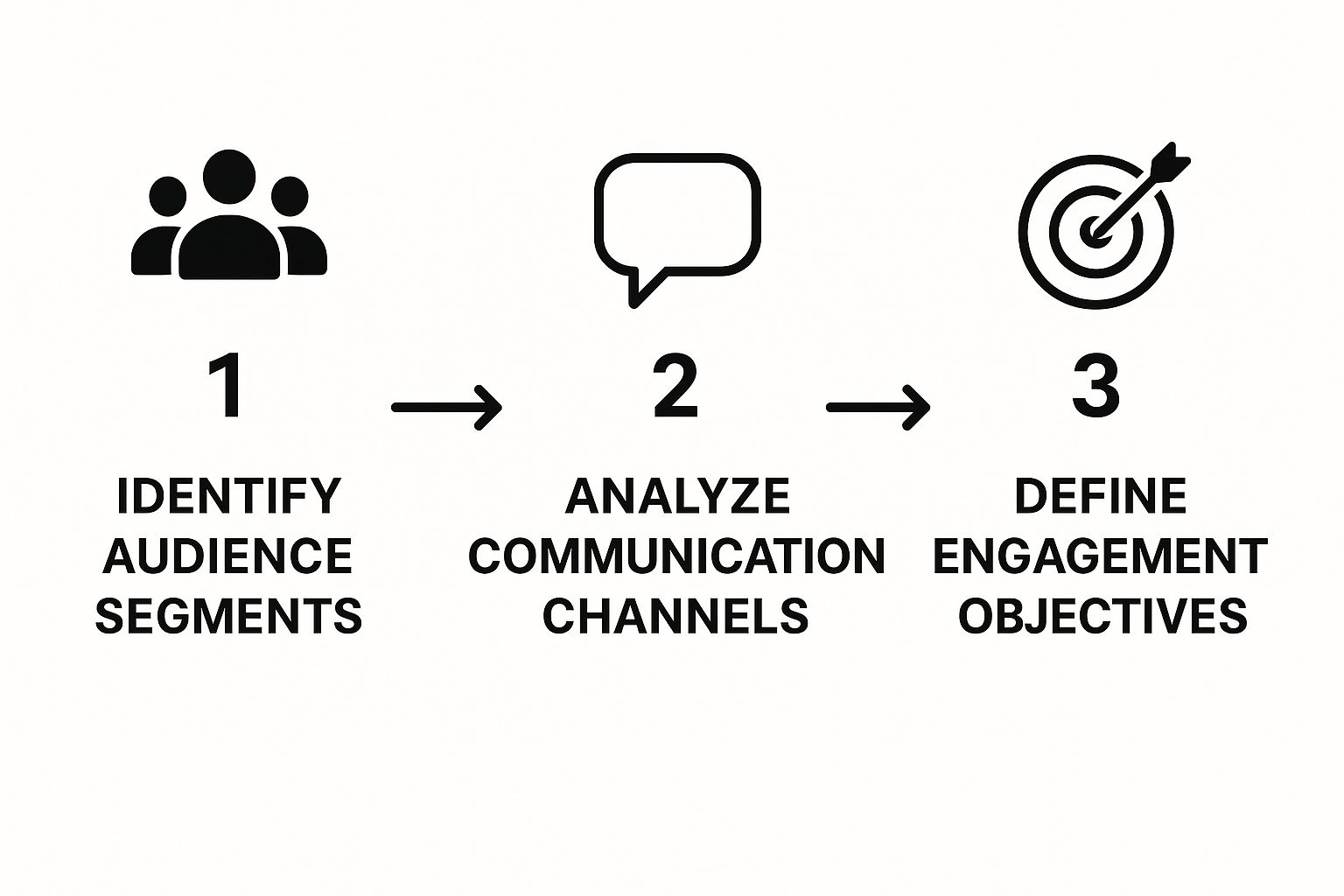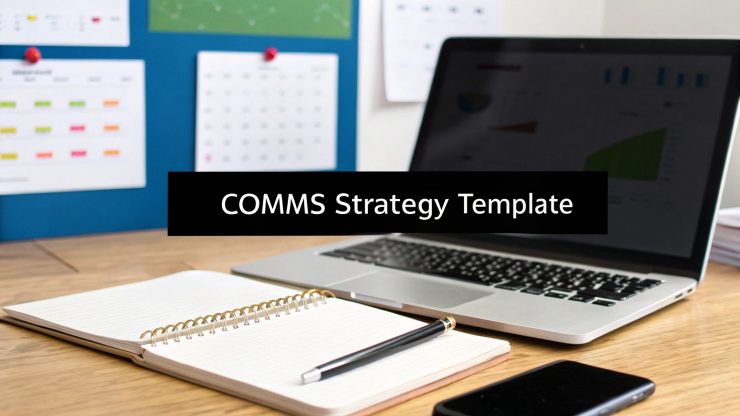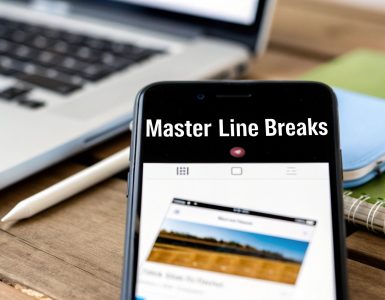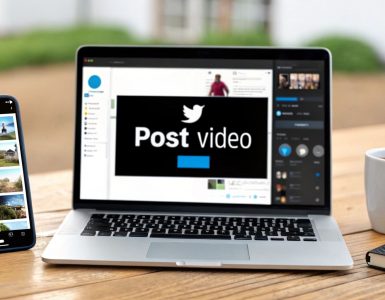We’ve all been there—staring at a blank document, tasked with building a communications plan from scratch. It’s a daunting feeling. That’s where a solid communication strategy template comes in. Think of it less as a rigid set of rules and more as a flexible, reusable framework that ensures every message, every campaign, and every internal update purposefully connects back to your core business goals. It's what shifts communication from a reactive, fire-fighting chore into a strategic function that genuinely drives value.
Why a Template Is Your Secret Weapon

When you don't have a clear roadmap, your communication efforts can easily feel scattered and almost impossible to measure. A well-built template fixes this by giving you a reliable structure for mapping out your goals, audiences, messages, and metrics. This isn’t about creating cookie-cutter plans; it’s about having a smart starting point that saves precious time and embeds strategic thinking into your team's DNA.
This structured approach forces you to ask the tough, important questions right from the start. Suddenly, you're planning proactively instead of just reacting to whatever comes up. Your team stops creating content just to fill a calendar and starts developing communication that's designed to achieve specific, meaningful outcomes.
From Busy Work to Business Impact
Let's be honest: one of the toughest parts of our job is proving our worth in clear business terms. It’s a common struggle—in fact, research shows nearly 50% of Chief Communications Officers find it difficult to connect their work to tangible business results beyond basic engagement stats. A template is your best defense against this problem, as it forces you to tie every single tactic back to a measurable business objective.
A communication strategy template isn't just a document; it's a tool for alignment. It ensures everyone, from the social media intern to the CMO, is operating from the same playbook and understands how their individual work contributes to the bigger picture.
By standardizing your planning, you build a system that you can use again and again, tweaking it as needed. This consistency is absolutely essential for building a strong foundation. For a deeper dive into how this works in practice, our guide on the differences between a communication plan and a strategy breaks down how these two concepts fit together perfectly.
The Essential Building Blocks of Your Plan
So, what goes into a high-impact communication strategy template? It’s built on a few core pillars. Each one plays a specific role, walking you from high-level objectives all the way down to the nitty-gritty of execution. Getting these building blocks right ensures nothing critical slips through the cracks.
Before we explore each component in detail, here's a quick overview of what makes up a truly effective communication strategy.
Core Components of a High-Impact Communication Strategy
| Component | Purpose | Key Question to Answer |
|---|---|---|
| Objectives & Goals | To define what success looks like in clear, measurable terms. | What specific business outcome are we trying to achieve? |
| Audience Segmentation | To identify and deeply understand the specific groups you need to reach. | Who exactly are we talking to, and what do they care about? |
| Key Messages & Narratives | To craft the core story you want to tell each distinct audience. | What is the single most important thing we need them to know or feel? |
| Channels & Tactics | To select the most effective platforms for delivering your messages. | Where does our audience spend their time, and how can we best reach them there? |
| Measurement & KPIs | To establish the metrics used to track progress and prove ROI. | How will we know if we’ve succeeded, and how will we report it? |
This framework provides the clear roadmap your team needs, turning abstract goals into a concrete, actionable plan. It creates a shared language and a standardized process, which makes collaboration smoother and your results far more predictable.
Breaking Down Your Communication Plan, Piece by Piece
A good communication strategy template isn't just a document to fill out; it’s a framework that forces you to think strategically. When you open it up, you’ll see a series of connected sections, each one designed to help you turn big-picture goals into real-world actions. Let’s walk through how to fill out each part thoughtfully, transforming that blank template into your roadmap for success.
The first thing you have to do is nail down your objectives. This is where precision is everything. A vague goal like "boost brand awareness" won't cut it. Instead, get specific. A strong business objective sounds more like: "achieve a 15% increase in qualified leads from our enterprise clients within the next two quarters."
The same goes for behavioral goals. Don't just say "get more people to use the new feature." A better, more measurable objective is: "get 50% of our current customers to actively use the new feature dashboard by the end of Q3." This level of detail makes your success something you can actually track and prove.
Know Your Audience, Nail Your Message
Once your objectives are crystal clear, it’s time to shift your focus to who you're actually talking to. You have to resist the urge to send the same message to everyone. Smart audience segmentation is about slicing your broad audience into smaller, more defined groups based on their needs, behaviors, or how they use your product.
Let's imagine you're launching a new software feature. Your audience isn't just "all users." It’s actually made up of distinct groups:
- Power Users: These are your tech-savvy champions. They want the nitty-gritty technical details and will be excited by advanced use cases.
- New Customers: These folks are likely still in a trial period. They need to see the immediate value and how easy the feature is to use. No jargon.
- Internal Teams: Your sales and support staff need their own version of the story. They need training, key talking points, and the confidence to explain the feature’s benefits to customers.
Each group needs a message crafted just for them. Your power users might get an email linking to a deep-dive blog post, while new customers get a simple, benefit-focused in-app pop-up. This targeted method ensures your message actually connects instead of just adding to the noise.
This chart really brings home the core idea of connecting your audience, channels, and goals.

As you can see, great communication follows a sequence. You start by understanding the audience, which then dictates your channel choice, which is ultimately what helps you hit your specific goals.
Picking the Right Channels for Real Impact
Your template should make you think hard about where you’re delivering these messages. The right channel is simply wherever your specific audience is most likely to listen. For your internal teams, a quick Slack announcement followed by a live training session is probably best. For those power users, a targeted email and a post in your online community forum will do the trick.
I’ve seen so many teams make the mistake of blasting the same message across every single channel they have. True strategy is about picking the fewest channels you need to create the biggest impact for each specific audience.
Communication templates are the tools that professional teams use to plan and run these kinds of campaigns. They have dedicated sections for everything from project goals to audience details, making sure nothing falls through the cracks. Exploring different frameworks can also give you fresh ideas. For a great overview of different approaches, check out these 9 Essential Corporate Communication Strategies.
By moving through your template section by section—from business goals to audience needs, key messages, and channel selection—you build a complete and practical plan. Each piece logically flows into the next, creating a powerful framework that ties every single communication effort directly back to what really matters: getting measurable results.
Setting KPIs That Prove Your Value

Let's be honest: a communication strategy without clear metrics is just a collection of good intentions. This is where your communication strategy template becomes a serious tool for accountability. It connects every email, post, and press release directly to a tangible business result. It’s time to get past the vanity metrics and start tracking the Key Performance Indicators (KPIs) that leadership actually understands and values.
Simply counting likes and impressions won't cut it anymore. While those numbers might offer a surface-level pulse on your activity, they rarely tell the full story of your impact. You demonstrate true value by showing how your work influenced customer behavior, boosted employee engagement, or directly supported revenue goals.
Beyond Vanity Metrics: The KPIs That Matter
The trick is to pick KPIs that tie directly back to the business and behavioral objectives you set earlier in your template. If your goal was to generate more qualified leads, then your primary KPI should be lead attribution from your communication channels, not just a general bump in website traffic.
Think about a PR campaign for a new product launch. Instead of just reporting the number of articles published, you should be tracking:
- Message Penetration: How many of your core messages actually appeared in the media coverage?
- Share of Voice: How does your media presence stack up against your top three competitors?
- Referral Traffic: How many people clicked through to your website from links in those articles?
This simple shift changes the conversation from, "We got a lot of buzz," to, "Our campaign drove 20% more qualified traffic to the product page." That's a result that gets attention.
Internal Communication KPIs
The same logic holds true for internal communications. If your objective is to improve employee alignment during a major company change, the number of emails you send is meaningless. What you really need to track are metrics that show a real shift in understanding and behavior.
A well-chosen KPI tells a story. It translates your communication efforts into the language of business outcomes, making it impossible for leadership to ignore the value you create.
Consider tracking these more powerful internal KPIs:
- Change Adoption Rate: What percentage of employees are actively using the new software or following the new process you communicated?
- Feedback & Question Volume: Are you seeing a decrease in repetitive questions to HR? This is a great indicator that your messaging is clear and effective.
- Employee Engagement Survey Scores: Can you see a measurable lift in specific survey areas tied to your campaign, like "I understand the company's vision"?
Building Your Measurement Dashboard
Your communication strategy template absolutely needs a dedicated section for your measurement dashboard. This doesn't have to be some complex, expensive software. It can be a simple table that pulls your most critical metrics into one place, serving as your single source of truth for tracking progress.
Here’s a straightforward structure you can adapt right inside your template:
| Objective | KPI | Current Baseline | Target | Actual Result |
|---|---|---|---|---|
| Increase customer adoption of new feature | Weekly active users of the feature | 500 users | 1,500 users | [To be updated] |
| Improve employee clarity on company goals | Q3 Employee Survey Score for "Understanding Strategy" | 65% Favorable | 80% Favorable | [To be updated] |
| Boost media share of voice for Q4 launch | Share of Voice vs. Competitor X & Y | 15% | 30% | [To be updated] |
This framework makes reporting incredibly simple and powerful. It allows you to monitor performance in real-time, pivot your tactics when something isn’t landing, and ultimately create compelling reports that prove the undeniable business value of your work.
Bending Your Template Without Breaking It

The best communication strategy template isn't a rigid document you follow to the letter. Its true value comes from its flexibility. I like to think of a core template as a reliable blueprint—a solid foundation you can build on for any situation your organization might run into.
Whether you're navigating a high-stakes crisis or drumming up excitement for a product launch, the fundamental pieces of your strategy are the same. What changes, often dramatically, is where you put your focus and energy.
A generic plan just won’t cut it when the pressure is on. Unique situations demand a specialized approach, and your template is the perfect launchpad. This is really what separates a team that's always putting out fires from one that's strategically ahead of the game.
How to Adapt Your Template for High-Stakes Scenarios
Let's get practical and look at how the focus of your template shifts for a few common business challenges. The structure holds steady, but the details and priorities look completely different.
-
During a Crisis: Your priorities become speed and control. The template immediately shifts to highlight immediate response protocols. You'll lean heavily on stakeholder mapping (figuring out who needs to know what, and in what order) and track sentiment analysis KPIs like your life depends on it. The main goal here is simple: manage the story and protect the brand’s reputation.
-
For a Product Launch: The mission flips entirely. Now, it's all about building buzz and driving people to try your new product. Your launch plan will be packed with media outreach lists, a detailed content marketing schedule, and lead generation KPIs. The audience section will get incredibly specific, with tailored messaging for your early adopters, loyal customers, and brand-new prospects.
This ability to pivot is what makes a template so powerful. You're not starting from a blank page every time a new challenge pops up. If you're just getting started, we've got a great overview in our guide on creating a template for communication strategy that can help you build your own.
A Real-World Example: Internal Change Management
Imagine your company is about to go through a major internal restructuring. This is happening more and more—the average employee experienced 10 planned enterprise changes in 2022, a massive leap from just two in 2016. A simple all-staff email won't fly. You need a dedicated internal change communication plan.
Here’s how you might adapt your template for this scenario:
| Template Section | Internal Change Focus | Example |
|---|---|---|
| Audience | Segment by department and how much they're impacted. | Leadership gets pre-briefed; teams directly affected get small, personal sessions. |
| Key Messages | Focus on why the change is happening and what it means for employees. | "This shift helps us serve our clients better, creating more stability and growth for all of us." |
| Channels | Prioritize channels that allow for two-way feedback. | Use manager-led huddles, anonymous Q&A tools like Slido, and regular town halls. |
| KPIs | Measure employee understanding and feelings, not just if the message was sent. | Track employee survey scores on clarity and notes from manager feedback sessions. |
Adapting your template is an art. It's about knowing which levers to pull for each scenario to make sure your message doesn't just get heard—it actually works and drives the right outcome.
This same principle even applies at a global level. The United Nations Economic Commission for Europe has called on statistical bodies to use proactive communication, clear key messages, and diverse channels to stay relevant—a lesson any organization can learn from.
When you get good at this adaptive approach, you ensure your communication is always sharp, relevant, and gets the job done.
Bringing Your Communication Strategy to Life
A brilliant strategy is useless if it’s just collecting dust in a folder. I've seen it happen too many times. The real magic happens when you turn that static document into a living, breathing system. This is where we shift from planning to doing—translating those carefully crafted messages and content pillars into a real-world workflow.
Let's start with your content calendar. This shouldn't be a space for just plugging in random ideas. It needs to be a direct reflection of the strategy you just built. Look at your content pillars and use them as your guide. For instance, if one of your pillars is "Showcasing Customer Success," maybe every Tuesday is now dedicated to a customer story, a detailed case study, or a powerful testimonial.
This simple habit ensures your daily output is always tied to your bigger goals. Your communication becomes consistent and purposeful, not scattered and reactive.
From Plan to Actionable Workflow
To make this truly manageable, I always recommend thinking in terms of content buckets. These are just categories of content, each designed to hit a specific goal.
Let's say you're a tech company. Your content buckets might look something like this:
- Product Education: Weekly tips, quick feature tutorials, and how-to guides.
- Industry Leadership: Monthly deep-dive articles, data-driven insights, and trend analysis.
- Company Culture: Bi-weekly team spotlights or some fun behind-the-scenes posts.
- Promotional Content: Timely announcements for sales or new feature launches.
When you categorize your content this way, you naturally create a balanced mix that speaks to different audience segments and serves your business objectives. And if you're ever stuck, you can find some practical social media post ideas to fill these buckets with fresh material that clicks with your audience.
The real goal here is building a system where the right type of content goes out at the right time, almost on autopilot. This frees you from the daily "what should I post?" grind and lets you focus on big-picture thinking and analyzing what's actually working.
Automating for Consistency and Growth
This is where a tool like EvergreenFeed becomes a game-changer. You can literally create content buckets inside the platform that perfectly mirror the pillars from your strategy. Go ahead and load each bucket with your best evergreen content—those timeless blog posts, foundational guides, and expert tips.
For example, you could set up your "Industry Leadership" bucket to share one article every single Thursday. EvergreenFeed will automatically pull a post from that collection and publish it for you through Buffer, ensuring a steady stream of high-value content goes out without you lifting a finger.
Suddenly, your communication plan isn't just a document; it's a self-sustaining engine. It guarantees consistent, on-brand messaging across all your channels, which is absolutely critical for building trust and authority.
But more importantly, it creates a feedback loop. By watching your analytics, you’ll see which content pillars resonate most with your audience. This allows you to double down on what works and refine your strategy over time, turning your template from a simple plan into an active tool for real growth.
Common Questions About Communication Planning
Even with a great template in hand, you’re bound to hit a few roadblocks or have some questions pop up. It happens to everyone. Let's walk through some of the most common sticking points I see teams run into.
One of the first questions people ask is, "How often should I actually update my communication strategy?" Think of your strategy as a living document, not a stone tablet. While the core vision and goals should be fairly stable, you'll want to review and tweak things quarterly.
This rhythm is perfect for reacting to what the data is telling you, responding to shifts in the market, or aligning with new company goals. You don't need to reinvent the wheel every few months, but a full-scale overhaul is probably a good idea once a year or if your company goes through a major change.
Another common point of confusion is just how detailed to get. "Should I be outlining every single tweet in here?" The real answer is: it depends on what you're planning.
For your high-level annual strategy, stay broad. Focus on the big picture—your primary objectives, target audiences, and main content themes. But when you’re mapping out a specific campaign, like a big product launch, that’s when you need to zoom in and get granular with detailed messaging, channel-specific tactics, and firm timelines.
Making Your Plan Realistic
This next one is a biggie: "What if we don't have the resources to execute this whole plan?" This isn't a sign of failure; it's a sign of being realistic. A solid template should actually force this conversation.
A perfect plan you can't execute is worse than a simple plan you can. Prioritize ruthlessly. Figure out what's "high-impact, low-effort" and do that first. Everything else can go in a "parking lot" for later.
Getting a few key things done exceptionally well builds momentum and proves value. Trying to do everything at once just leads to burnout and mediocre results.
Finally, people often wonder about the difference between a plan and a strategy. It's a great question because the terms get thrown around interchangeably all the time.
Here’s the simplest way I can put it: your strategy is the big-picture "what" and "why." Your plan is the nitty-gritty "how" and "when." If you want to dive deeper, we have a complete guide that breaks down the difference between a communication plan and a strategy. Getting this right is fundamental to making your template work for you.
Ready to stop the manual grind and put your evergreen content to work? EvergreenFeed automates your social media scheduling, so you can build a consistent, powerful presence without the daily effort. Start your free trial today and see the difference.




